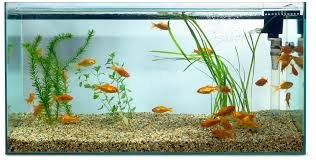Stocking your aquarium with freshwater fish is a terrific alternative if you’re thinking about doing so. Fish enthusiasts have their pick of many different species, each with its own quirks and special qualities. However, there is a minimum level of care that must be provided for all freshwater fish. The health and happiness of your fish depend on the conditions you create for them. If you keep a regular feeding and cleaning regimen, your fish will live for many years.
Keep the Fish Tank Fish-Friendly

Regular tank cleaning is crucial to the health of an aquarium. While sources suggest changing out only 25% of the water every two weeks, Israel advocates replacing up to 50% of the water every week. Remove some of the water from the tank and replace it with treated tap water of the same temperature.
Aquaria with freshwater fish should be kept between 72 and 78 degrees, as recommended by Israel. While this range should be fine for the vast majority of freshwater fish, there are a few species that do better in either very cold or very warm water. To keep your fish community healthy, you should invest in a heater and a thermometer.
Check and Keep an Eye on Water Readings

So, how can you determine if the water is suitable for your fish? Investing in a cheap water testing kit to check for ammonia, nitrates, nitrites, and pH is a wise decision. For accurate results, use the API Master Test Kit. As a manager, you’ll like how straightforward the outcomes are. With weekly testing, a single kit can endure for months if not years.
Chemicals like ammonia, nitrates, and nitrites are produced by biological processes in your tank. Low concentrations are safe, but excessive exposure can be harmful. Make sure the water parameters are always accurate by following the directions on the test kit.
The kit can also be used to determine the water’s pH level. Fish are generally tolerant of a wide range of pH values, but in really hard water, it may be essential to use chemicals to lower the pH.
Make Sure There Is Enough Room And Light

There is widespread agreement that you should get your fish in at least a 20-gallon tank. To delay the onset of water contamination, a larger tank should be used. Although there is some debate about the optimal fish population for given tank size, it’s safer to err on the side of caution and retain fewer, larger fish. If you want to buy fish, you should consult with the knowledgeable staff in the aquatics department about the amount of room each species requires.
Maintaining a consistent light source is important for the health of your freshwater fish and aquatic plants. Israel warns that too much light in the tank can cause algae to bloom, therefore constant scraping of the algae off the tank’s sides and any decorative things inside the aquarium is essential. Israel recommends using a timer-equipped aquarium light to manage the amount of light they’re exposed to. In this manner, you can enjoy your fish while the light is on, but it will turn off when you leave or go to bed.
Feeding Aquarium Fish

Overfeeding the fish breaks one of the three laws of fishkeeping. Leaving food in a tank that isn’t eaten quickly turns into a waste product that contaminates the water. Too much care leads to the fish’s demise. The rule of thumb is to feed only what the fish can eat in under five minutes.
Dry flake food is a good option for most fish. You must only use premium, name-brand food products. You should stock up on a range of flake meals and rotate between them when feeding your pet. In doing so, we can make sure the fish are getting a well-rounded diet.
Pellet meals, which are more substantial, are preferable for larger fish and many species of catfish. Feeding freeze-dried foods to fish is a great idea, especially for those species with high protein requirements. You can make sure your fish are eating a balanced diet by supplementing their regular food with fresh-frozen or live foods on occasion.
You should always keep in mind the expiration dates on packaged items when you go grocery shopping. Wherever you go, if the containers are dusty or appear to have been on the shelf for a while, you should search elsewhere.
Spend your money on compact packaging. While it’s true that stocking up on larger quantities saves money, the moment you crack open the packaging the food’s nutritious value begins to decline.
The nutritious content of food quickly declines after being stored for three to six months, with just about half of the original value remaining after that time. As a result, unless you have enough fish to eat the entire bag within a few months, you shouldn’t buy bulk-packaged flake feeds.
Also, know Do Koi Eat Other Fish?
Flake feeds designed specifically for vegetarian fish have significantly more vegetable matter and far less protein. Additional foods, including freeze-dried, frozen, and even live foods, can be purchased from the aquarium shop and served in addition to the flake foods.
Cycling Your Tank

Before adding fish, you must ensure that your aquarium is completely set up in order to begin cycling the tank. Make a decision, set up your tank, and then add the washed substrate. Then, put in your air stones or pumps and water. After that, you can bring in your freshly washed plants and ornaments. In the end, you’ll want to install a filter and, if necessary, a heater. Start the pumps and filter and let it run for a few days. At that point, you can gradually introduce some hardy fish like guppies and danios. It’s important to give beneficial bacteria a chance to multiply so that toxins may be filtered out and the fish can live. Replace 10-25 percent of the water every few days. If the water you plan on using has been chlorinated in any way, you’ll want to remove the chlorine or use a water conditioner before putting it in the tank. These substances are typically sold in pet stores. You should get a test kit and check the levels of the poison every day until they are within range. Once nitrate and ammonia levels drop below detection thresholds, cycling has ended.
How to Avoid Illness?
Diseases can quickly spread across a tank and cause devastating losses. Keep the water quality at a high standard. Regular testing and adjusting of the chemical balance is essential. Do not put your fish through any undue stress, as this can increase their vulnerability to illness. Finally, if you see a sick fish, take it from the tank and place it in quarantine until it recovers. Keep an eye out for additional fish that might be showing symptoms of illness.





